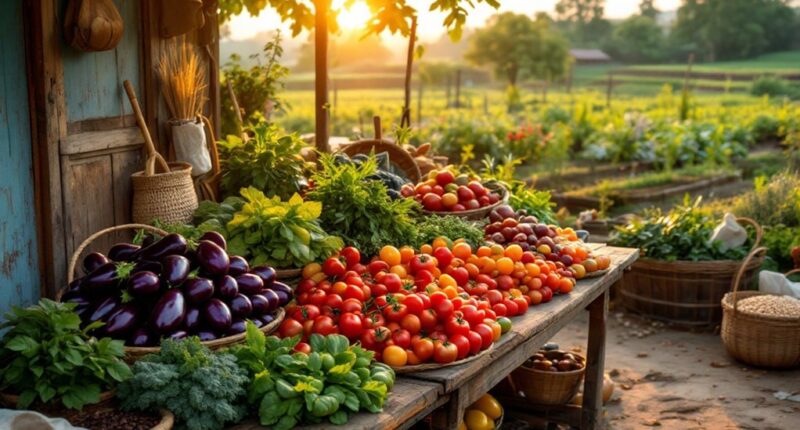Food sovereignty empowers communities to control their own food systems, placing democratic decision-making at the heart of agriculture. Unlike corporate models, it treats nutritious food as a fundamental human right while promoting ecological responsibility. Small-scale farmers thrive under this approach, preserving traditional seed varieties and implementing agroecological methods that work with nature rather than against it. Despite challenges from corporate concentration and climate change, this movement continues gaining momentum in over 80 countries, offering a blueprint for truly sustainable agriculture.

The dinner plate, often taken for granted, represents the endpoint of a complex global system that determines not just what we eat, but who profits, who suffers, and how our planet fares in the process. Behind each meal lies a web of decisions that shape our health, communities, and environment. This is where food sovereignty enters the conversation – not merely as a concept, but as a revolutionary approach to reclaiming control of our food systems.
Food sovereignty champions the radical notion that communities should determine their own food and agricultural policies. Unlike the corporate food model – which treats food like any other tradable commodity – food sovereignty views nutritious food as a fundamental human right. It’s fundamentally democracy served on a plate, with a side of ecological responsibility.
Food sovereignty: where democracy meets agriculture, and communities—not corporations—decide what’s for dinner.
At its core, this movement values the people who actually produce our food. While agribusiness executives might not know one end of a pitchfork from another, small-scale farmers hold generations of agricultural wisdom. Food sovereignty puts these producers – not corporations – at the decision-making table. As one farmer put it, “We’re experts in growing food, not just cogs in someone’s supply chain.”
The benefits ripple outward like concentric circles in a pond. Local food economies thrive when producers receive fair compensation. Traditional seed varieties – nature’s genetic treasure chest – remain preserved rather than replaced by patented corporate alternatives. Agroecological methods work with natural systems instead of battling them with chemical arsenals. Organizations like La Via Campesina promote agroecological peasant agriculture as a central strategy for advancing food sovereignty globally. Since the Declaration of Nyéléni in 2007, the concept has gained recognition in over 80 countries as a viable framework for sustainable food systems.
Of course, challenges loom large. Corporate concentration in the food sector resembles a game of agricultural Monopoly where five players own nearly everything on the board. Trade policies often favor industrial agriculture, while climate change disrupts traditional growing patterns.
Yet the global movement grows stronger daily. From La Via Campesina’s international organizing to indigenous communities protecting ancestral practices, food sovereignty advocates are crafting alternatives to the industrial food model. Their message is clear: sustainable food systems aren’t just about what we eat, but about who controls how it reaches our plates.
Frequently Asked Questions
How Can Individual Consumers Support Food Sovereignty Initiatives?
Consumers can meaningfully support food sovereignty by purchasing directly from local and Indigenous producers through farmers’ markets and CSA programs.
They can prioritize products with Indigenous certifications and participate in community food events featuring native chefs.
Individuals make an impact by joining food co-ops, community gardens, and seed-saving projects. Additionally, educating themselves about traditional foodways and advocating for policies that promote sustainable agriculture creates lasting systemic change.
What Are Common Challenges to Implementing Food Sovereignty Principles?
Implementing food sovereignty principles faces multi-layered challenges. Structurally, corporate dominance and unfavorable trade policies limit small farmers’ ability to compete. Government policies often prioritize industrial agriculture, while intellectual property restrictions on seeds undermine traditional practices.
Environmental pressures—climate change, biodiversity loss, and soil degradation—further complicate matters. Additionally, urbanization has disconnected people from food production, while cultural shifts toward processed foods have eroded traditional knowledge. These barriers require coordinated responses across economic, political, and social dimensions.
Who Funds Community-Controlled Food Systems?
Community-controlled food systems draw funding from diverse sources. Government agencies like USDA provide millions through programs like Community Food Projects and Farmers Market Promotion.
Foundations such as Danone Institute and Wildseeds Fund contribute substantial grants. Private sector options include RSF Social Investment loans ranging from $50k-$400k and impact investors.
Grassroots funding comes through innovative models like Community Supported Agriculture, cooperatives, crowdfunding campaigns, and community land trusts that collectively empower local food autonomy.
How Do Food Sovereignty Movements Address Cultural Food Traditions?
Food sovereignty movements honor cultural food traditions through multiple approaches. They preserve traditional knowledge by facilitating intergenerational teaching of production, harvesting, and preparation techniques.
Communities actively promote consumption of culturally significant, nutrient-dense foods which reinforce cultural identity. Land reclamation efforts, like the Muckleshoot Tribe’s acquisition of 93,000 acres, enable revival of traditional harvesting practices.
These movements prioritize community participation, engaging elders and tribal leaders in developing culturally relevant food initiatives that respect indigenous ownership of traditional food knowledge.
Can Food Sovereignty Work in Urban Environments?
Food sovereignty initiatives are thriving in urban environments through community gardens, urban farms, and public orchards. Cities like Seattle and Baltimore demonstrate how urban agriculture can increase access to fresh, culturally appropriate foods while building community resilience.
Despite challenges like limited land access, high property costs, and restrictive zoning regulations, urban communities are successfully implementing strategies through supportive policies, educational programs, and partnerships between community organizations and local governments to create sustainable urban food systems.









